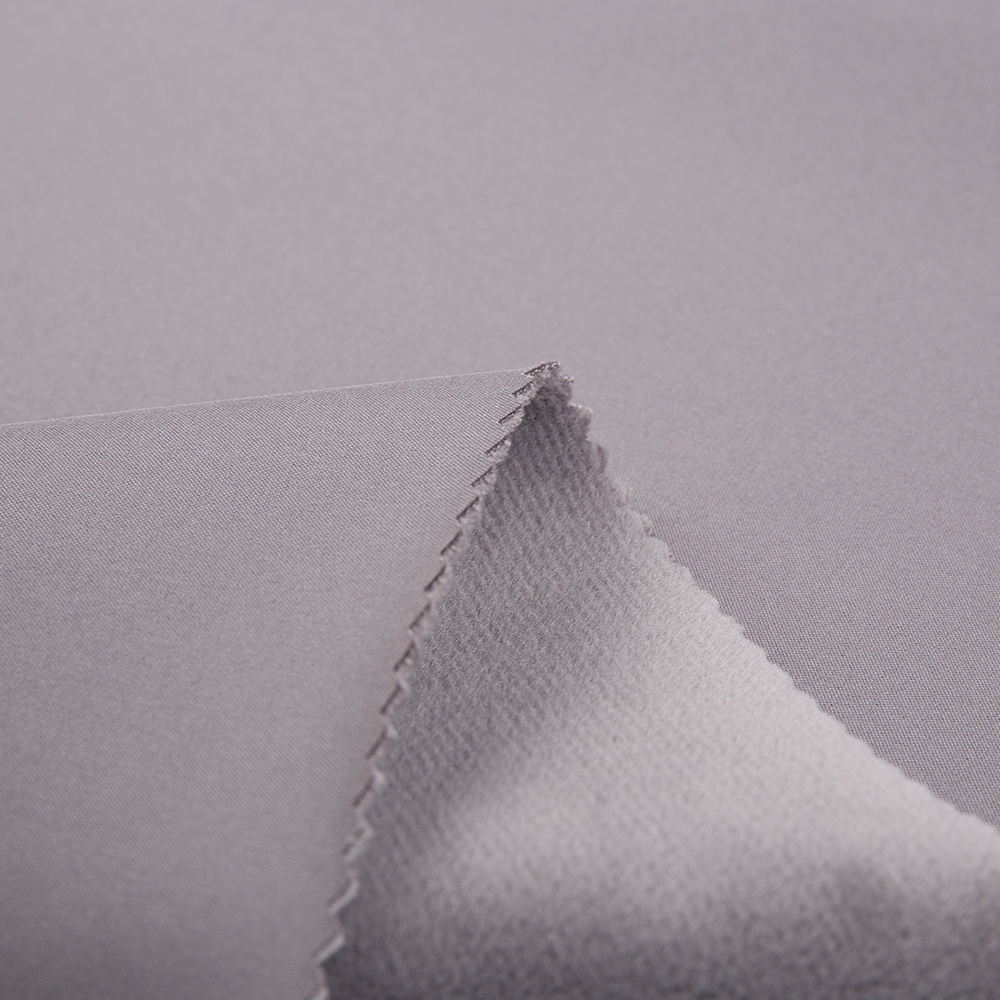Softshell fabric is typically constructed using a multi-layer approach to optimize its performance in outdoor and active wear applications. These layers and construction techniques work together to balance water resistance, windproofing, breathability, and durability. Here's a breakdown of the common layers and how they contribute to the fabric's overall performance:
1. Outer Layer (Face Fabric):
Material: The outer layer of softshell fabric is often made from durable synthetic fibers like polyester, nylon, or elastane. These materials provide the fabric with flexibility, stretch, and abrasion resistance.
Function: This layer serves as the first line of defense against wind and water. The tightly woven construction helps to repel water and wind, offering some resistance to light rain and wind without being completely waterproof (which is more common in hardshell fabrics). The outer fabric's durability also protects the inner layers from abrasion and wear.
Water Resistance: Often treated with a DWR (Durable Water Repellent) finish to enhance water resistance, the face fabric beads water on the surface rather than allowing it to soak in. While this layer is not fully waterproof, it is highly effective in light rain or snow.
2. Middle Layer (Insulating or Moisture-Wicking Layer):
Material: The middle layer can vary depending on the fabric’s intended purpose. For colder weather, a thin layer of fleece or brushed fabric may be added for warmth, or a lightweight insulation material like microfleece or PrimaLoft may be used. Some softshell fabrics may not have a dedicated middle layer but instead rely on the properties of the outer fabric itself.
Function: This layer adds thermal insulation and helps manage moisture by wicking sweat away from the body. In cold or windy environments, this layer provides additional warmth without compromising breathability.
Breathability: One of the key benefits of softshell fabrics is their breathability, allowing sweat and moisture to escape from the inside while blocking wind from the outside. The middle layer works with the outer layer to maintain this balance, especially during high-intensity activities like climbing or hiking.
3. Inner Layer (Lining or Base Layer):
Material: The inner layer is typically made of a soft, smooth fabric such as fleece, microfleece, or brushed polyester. In some cases, it could be a specialized moisture-wicking material that helps move sweat away from the body.
Function: The inner layer provides comfort against the skin and enhances breathability. It also adds some additional warmth, especially if made from fleece or similar materials. This layer’s smoothness ensures that the fabric doesn’t cling to the skin, reducing friction and improving comfort during physical activity.
Moisture Management: As softshell fabrics are often worn in dynamic, high-output conditions, this layer’s moisture-wicking properties help to manage sweat and keep the wearer dry. It allows for faster evaporation of moisture, which is crucial in preventing the wearer from getting cold when stopping for breaks.
4. Bonded Construction (Lamination):
Construction: Some softshell fabrics use a bonded construction, where the outer, middle, and inner layers are bonded together using an adhesive or through a lamination process. This construction ensures the fabric remains lightweight, flexible, and durable, while still maintaining a clean, smooth surface.
Function: Bonding helps to eliminate bulk and seams, providing a more streamlined, less restrictive fit for the wearer. This technique can also help improve water resistance by sealing the layers together and reducing the likelihood of water seeping through.

5. Windproof and Waterproof Membranes (Optional):
Membranes: Some softshell fabrics incorporate an additional waterproof or windproof membrane layer (like eVent, Gore Windstopper, or Sympatex). These are often sandwiched between the outer layer and the insulating layer.
Function: This membrane provides enhanced protection against wind and rain, improving the fabric’s overall resistance to harsher weather conditions. It is designed to be breathable, allowing moisture to escape while keeping wind and water out. However, adding a membrane can reduce breathability slightly, so it is often used in more specialized softshells meant for severe conditions.
How These Layers Improve Performance:
Water Resistance: The outer layer, treated with a DWR coating, repels water and helps to prevent moisture from soaking into the fabric. While not waterproof, softshell fabric can handle light rain and snow with ease. Some models may include an additional water-resistant membrane for more extreme conditions.
Windproofing: The tightly woven structure of the outer fabric and the addition of windproof membranes (when included) significantly reduce wind penetration. This makes softshell fabric a great choice for wind protection in outdoor environments.
Breathability: One of the key advantages of softshell fabric is its breathability. The middle and inner layers allow moisture (sweat) to escape while preventing cold air or water from getting in. This is crucial for maintaining comfort during physical activities, as it prevents overheating while keeping you dry.
Durability: The combination of abrasion-resistant fibers in the outer layer (often nylon or polyester) and the laminated or bonded construction helps softshell fabrics withstand rough conditions. This makes softshells ideal for outdoor activities like hiking, climbing, and skiing where durability is essential.
Comfort and Mobility: The stretchable nature of softshell fabrics allows for a high degree of flexibility, enhancing the wearer’s mobility. The inner fleece or brushed fabric provides a soft, comfortable feel against the skin, ensuring comfort during prolonged wear.











